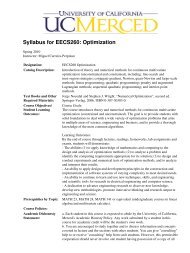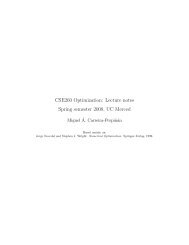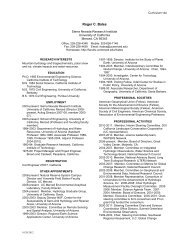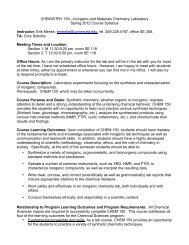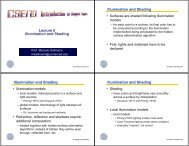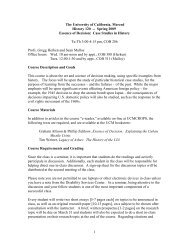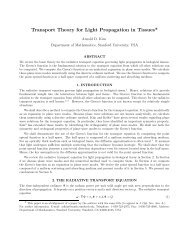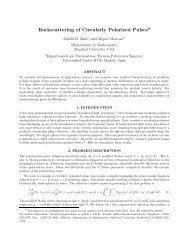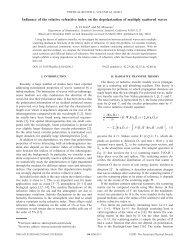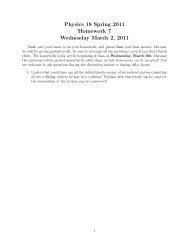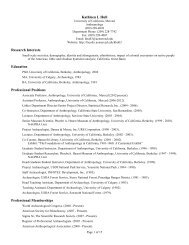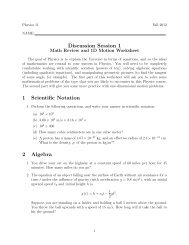The Legal Advocacy Network Thomas G. Hansford Associate ...
The Legal Advocacy Network Thomas G. Hansford Associate ...
The Legal Advocacy Network Thomas G. Hansford Associate ...
You also want an ePaper? Increase the reach of your titles
YUMPU automatically turns print PDFs into web optimized ePapers that Google loves.
<strong>The</strong> <strong>Legal</strong> <strong>Advocacy</strong> <strong>Network</strong><br />
<strong>Thomas</strong> G. <strong>Hansford</strong><br />
<strong>Associate</strong> Professor of Political Science<br />
School of Social Sciences, Humanities, and Arts<br />
University of California, Merced<br />
5200 North Lake Rd.<br />
Merced, CA 95343<br />
thansford@ucmerced.edu<br />
http://faculty.ucmerced/edu/thansford/<br />
Paper prepared for presentation at the annual meeting of the American Political Science<br />
Association, Washington, DC, September 2-5. This research has been supported by a UC<br />
Merced GRC Faculty Research Grant. I wish to thank Alaine Abesamis, Alisen Boada, Chris<br />
Hoeft, Adam Kook, and Shane Young for their research assistance.
<strong>The</strong> <strong>Legal</strong> <strong>Advocacy</strong> <strong>Network</strong><br />
While prior work provides a good deal of information on the aggregate patterns of organized<br />
interest involvement at the Supreme Court and the individual-level decisions to file amicus<br />
briefs, we know little about the structure of the large, diverse community of interests that lobby<br />
the Court. This paper presents an initial effort to apply the concepts and tools of social network<br />
analysis to better identify, describe, and understand this structure, which I term the legal<br />
advocacy network. I first define, measure, and illustrate the advocacy network at the Supreme<br />
Court from the 1953 to 2006 terms. I then turn, in order, to discussing, and in places tentatively<br />
demonstrating, how these network data can be fruitfully used to gain leverage on 1) individual<br />
interests, 2) the organized interest community, and 3) important characteristics of Supreme Court<br />
cases.
One of the defining features of the modern U.S. Supreme Court is the heavy involvement<br />
of organized interests, typically through the filing of amicus curiae briefs (i.e., third party “friend<br />
of the Court” briefs). By filing these briefs, interests “lobby” the Court in an effort to influence<br />
the legal policy established by this key governmental institution (Barker 1967). While there is<br />
still some debate regarding the causal effect these briefs have on the Court’s decisions on the<br />
merits (e.g., Collins 2008; Songer and Sheehan 1993) and its majority opinions (e.g., Spriggs and<br />
Wahlbeck 1997), it is clear that the Supreme Court is a prime target for the advocacy efforts of a<br />
wide variety of interests. In the 2006 Term, for example, 566 amicus briefs with a total of 2,490<br />
organizational cosigners were filed by 1,346 unique organized interests, ranging from citizen<br />
groups to professional associations to corporations to governments.<br />
Prior work provides a good deal of information on the aggregate patterns of interest<br />
involvement at the Supreme Court (Caldeira and Wright 1990; <strong>Hansford</strong> 2009) and the<br />
individual-level decisions to file amicus briefs (<strong>Hansford</strong> 2004a, 2004b; Scheppele and Walker<br />
1991). We know little, however, about the structure of the interest communities that lobby the<br />
Court (but see Box-Steffensmeier and Christenson 2010). In fact, despite a great deal of<br />
attention by political scientists we have little systematic knowledge of how the population of<br />
organized interests in the U.S. is generally organized.<br />
This paper presents an initial effort to apply the concepts and tools of social network<br />
analysis to better identify, describe, and understand the structure of the large, diverse community<br />
of interests that lobby the Court. Despite a long and substantial history of use in sociology in<br />
particular, social network analysis has rarely been applied to interest groups or courts. 1<br />
By<br />
1 Notable exceptions include Fowler et al.’s (2007) use of network analysis to measure the importance of precedents<br />
at the Court, Koger and Victor’s (2009) campaign contribution-based network of members of Congress, and Box-<br />
Steffensmeier and Christenson’s (2010) amicus cosigner network in recent Court terms.<br />
1
formalizing and analyzing what I term the “legal advocacy network,” researchers may be able to<br />
better identify important macro-level features of the interest population, or at least of the subset<br />
engaged at the Court. For example, analyses of the legal advocacy network can reveal whether<br />
interests are effectively organized into a very small set of cores which presumably correspond to<br />
general ideological positions. Alternatively, it may be the case that the interest population is<br />
organized into a large number of fairly discrete, issue-specific cores. <strong>The</strong> legal advocacy<br />
network will also reveal interesting information about the characteristics and roles of the<br />
individual interests composing the network. For instance, central interests in the network can be<br />
identified.<br />
Furthermore, these data and approach may very well yield interesting information about<br />
the Court as an evolving institution, since macro-level features of the interest community<br />
structure are likely reflective of the nature of the Court at a given point in time. <strong>The</strong> number and<br />
nature of the interest cores discussed above could reveal the nature of the Court’s agenda.<br />
Finally, information gleaned from the advocacy network may provide researchers with useful<br />
information about specific Supreme Court cases, such as the breadth of the legal issue at hand or<br />
the ideological loading of the case.<br />
This paper unfolds in the following manner. I first define, measure, and illustrate the<br />
advocacy network at the U.S. Supreme Court from the 1953 to 2006 terms. Importantly, these<br />
data span all the issues considered by the Court over a lengthy period of time, allowing me to<br />
avoid the problem of policy-domain specificity (see Baumgartner and Leech 1998). I then turn,<br />
in order, to discussing, and in places tentatively demonstrating, how these network data can be<br />
fruitfully used to gain leverage on 1) individual interests, 2) the organized interest community,<br />
and 3) important characteristics of Supreme Court cases.<br />
2
Defining the <strong>Legal</strong> <strong>Advocacy</strong> <strong>Network</strong><br />
A social network is composed of nodes and the ties that link them. 2<br />
Organized Interests as Nodes<br />
3<br />
In assembling the<br />
social network of organized interests that lobby the U.S. Supreme Court, I treat organized<br />
interests as the nodes and the filing of amicus curiae briefs on the merits of the same case as ties.<br />
To use two well-known and well-studied (e.g., Kobylka 1990; Vose 1959) interests, if the ACLU<br />
and NAACP both filed an amicus curiae brief in Supreme Court case A then I consider this as a<br />
tie between the two interests. If the ACLU and the NAACP take the same position on the merits<br />
of the case (i.e., they both argue for reversal of the lower court or they both argue that the<br />
decision should be affirmed) then this is a positive tie between the interests. If, on the other<br />
hand, these two interests take opposing positions on the merits of case B then this is a negative<br />
tie. How nodes and ties are defined in a network is of critical importance, and thus these choices<br />
are detailed below.<br />
<strong>The</strong> nodes in the legal advocacy network are organized interests. <strong>The</strong> issue then becomes<br />
what constitutes an organized interest. Consistent with Caldeira and Wright (1990) and<br />
Schlozman and Tierney (1986), I cast a very wide net here and consider any organized entity to<br />
be an organized interest. I thus include, for example, public interest groups, unions,<br />
governments, businesses, business associations, professional associations, and universities as<br />
nodes in the network. I exclude only individuals who filed or cosigned an amicus brief as an<br />
individual. 3<br />
2 See Jackson (2008) and Wasserman and Faust (1994) for introductions to social network analysis.<br />
3 This approach is also consistent with Gibson (1997).
At this point, I only include organized interests as nodes, meaning that this is a single<br />
mode network. Future extensions of this research will add justices to the network, which will<br />
then yield a two mode network.<br />
Amicus Ties<br />
<strong>The</strong>re are two possible ways in which to use amicus curiae briefs to define ties between<br />
organized interests. As stated above, I consider filings of amicus briefs in the same case as ties.<br />
Alternatively, I could use a more restrictive approach and only treat the cosigning of an amicus<br />
brief as a tie (Box-Steffensmeier and Christenson 2010). To make clear the differences between<br />
these two approaches, Table 1 provides a small subset of the amicus briefs filed in Kelo v. City of<br />
New London (2005). <strong>The</strong> table lists two amicus briefs filed in support of the petitioner (i.e., in<br />
support of disallowing the taking of private property in this case) and one amicus brief filed in<br />
support of the respondent (i.e., in support of the constitutionality of the taking of the property).<br />
One of the pro-petitioner briefs was filed solely by the Property Rights Foundation of America<br />
while the other was filed by (cosigned by) both the Mountain States <strong>Legal</strong> Foundation and<br />
Defenders of Property Rights. <strong>The</strong> amicus brief supporting the respondent was filed by<br />
(cosigned by) the National League of Cities, National Association of Counties, and Council of<br />
State Governments.<br />
*** Table 1 Here ***<br />
If ties are defined as existing only between cosigners of a brief, then these three briefs<br />
yield a total of eight symmetric ties (listed in the last column of Table 1). If ties are defined by<br />
filing amicus briefs in the same case, then there exist 12 symmetric positive ties (listed in the<br />
first column) and 18 symmetric negative ties (listed in the second column). Under the former<br />
approach, the Property Rights Foundation of America is not tied to any other interest while with<br />
4
the latter it has positive ties to the Mountain States <strong>Legal</strong> Foundation and Defenders of Property<br />
Rights and negative ties to the three interests filing on behalf of the respondent.<br />
<strong>The</strong>re are three potential theoretical advantages to treating only cosignings as ties, the<br />
first of which is that cosigners are obviously presenting the exact same arguments and<br />
information to the Court. Second, it may be safer to assume that generally speaking there is<br />
more in the way of explicit communication between cosigners than between interests filing<br />
separate briefs. Third, if scholars are primarily interested in the formation of organized interest<br />
coalitions, then the cosigning of a brief is a clearer joining of a coalition than the filing of<br />
separate briefs (Box-Steffensmeier and Christenson 2010).<br />
<strong>The</strong>se three potential advantages should not be overstated, however. Filers on the same<br />
side of a case may provide different specific arguments, but by definition they ultimately adopt<br />
and endorse the same fundamental position. It also appears that there is communication between<br />
interests on the same side of a Supreme Court case or general legal issue, regardless of whether<br />
they are cosigning the same brief (e.g., Behuniak-Long 1991; O’Connor and Epstein 1982).<br />
Coalitional or coordinated behavior may be occurring regardless of whether briefs are cosigned<br />
or filed separately.<br />
Furthermore, there is strong theoretical reason for using the filing of amicus briefs in the<br />
same case as a tie, the approach I choose to employ, instead of using only cosignings. Filing<br />
amicus briefs on the same position in the same case, regardless of cosigner status, provides<br />
important information about the relationship between interests. Returning to Table 1, the fact<br />
that the Property Rights Foundation of America, Mountain States <strong>Legal</strong> Foundation, and<br />
Defenders of Property Rights all chose to file an amicus brief supporting Kelo reveals important<br />
information about the similarities in agenda and policy preferences of these three interests.<br />
5
Using only cosignings would overlook this expressed connection between the Property Rights<br />
Foundation of America and the other two interests.<br />
Using only cosignings also does not allow for negative ties, which are theoretically<br />
important. Using amicus briefs filed on opposing sides of a case as negative ties provides more<br />
information about the relationship between interests and will allow researchers to better locate<br />
these interests in the advocacy network. Negative ties also allow social network analysis tools to<br />
be brought to bear on questions regarding the existence of rival cores in the network and their<br />
implications for both the organized interest population and the Supreme Court as an institution.<br />
On a related empirical note, using the filing of briefs in a case to determine ties is<br />
advantageous because the additional information allows for richer analyses of the advocacy<br />
network. If just cosignings were used as ties, earlier Court terms yield networks that are not<br />
particularly meaningful or interesting. In the 1955 Term, for example, the cosigning approach<br />
would yield only 42 symmetric ties (21 edges in the graph) involving a grand total of 15<br />
organized interests. <strong>The</strong> other 33 interests filing amicus briefs in this term would be effectively<br />
excluded from the network. Moreover, each brief with multiple interests would represent a fully<br />
isolated component in the network, meaning that there would be no ties connecting across cases.<br />
Little in the way of meaningful analyses could be conducted with such a minimal network.<br />
<strong>The</strong>refore, for both theoretical and practical, empirical reasons, I choose to use the filing of<br />
amicus briefs in the same case as ties in the network, instead of just cosignings of a brief. 4<br />
4 <strong>The</strong> vast majority of the amicus briefs filed in the 1953 through 2005 terms take a position on the case (e.g.,<br />
support the petitioner). Five percent of the briefs, however, do not take a position. It cannot be safely assumed that<br />
all “neutral” briefs in a case imply a positive tie between the interests filing these briefs. It can be assumed,<br />
however, that all cosigners of a neutral brief share a positive tie. Thus, I include a positive tie for all cosigners of a<br />
neutral brief but do not include ties between neutral briefs. I also do not view interests on a neutral brief as having<br />
negative ties with either pro-petitioner or pro-respondent interests.<br />
6
Data<br />
Data on the amicus curiae briefs filed on the merits of Supreme Court cases and the<br />
organized interests that filed them come from three sources. First, the United States Supreme<br />
Court Judicial Database - Phase II (Gibson, 1997) provides data on the amicus curiae briefs<br />
submitted on the merits for the 1953 through 1985 terms of the Supreme Court. <strong>The</strong>se data only<br />
include up to 11 cosigners per brief, so for all briefs that had at least 11 cosigners I used Lexis<br />
and Briefs and Records of the United States Supreme Court to identify additional cosigners. For<br />
the 1986 through 2006 terms, I relied exclusively on Lexis and Briefs and Records of the United<br />
States Supreme Court to identify all amici.<br />
As described above, the amicus curiae brief data were then used to identify positive and<br />
negative ties between organized interests for a particular case. Both positive ties and negative<br />
ties were then separately aggregated for each organized interest dyad for each Supreme Court<br />
term. Using a pair of dyads from the Kelo example, this aggregation process reveals that for the<br />
term in which Kelo was decided (the 2004 Court Term) the Property Rights Foundation has a<br />
total of two positive ties with the Defenders of Property Rights, which in turn has a total of two<br />
negative ties with the National League of Cities. Thus, at the term-level the ties between<br />
interests are valued, meaning that they are not simply binary. <strong>The</strong> positive tie between the<br />
Property Rights Foundation and Defenders of Property Rights has a value of two for the 2004<br />
Term.<br />
I do not aggregate the data beyond the term level due to two difficulties with identifying<br />
unique organized interests. First, organized interests occasionally change their names over time,<br />
and there will be situations in which an organized interest with name X in 1965 is actually the<br />
same entity as an interest with name Y in 1995. If the data are pooled over the decades, I may<br />
7
unknowingly treat these as distinct interests. Second, organized interests (businesses, in<br />
particular) can merge or split over time and this poses the problem of deciding whether a<br />
subcomponent of a past or future interest should be considered as the same entity. By<br />
aggregating ties by the Court term, I largely avoid these issues.<br />
In summary, I use amicus curiae brief filings on the merits of Supreme Court cases to<br />
identify positive and negative ties between the organized interests filing these briefs. <strong>The</strong>se ties<br />
are then aggregated for each of the Court terms from 1953 to 2006. <strong>The</strong> end product is 54 term-<br />
specific legal advocacy networks consisting of organized interests as nodes and brief-based ties.<br />
Both the positive and negative ties are symmetric, non-directed, and valued. By symmetric and<br />
non-directed, I mean that if the ACLU is positively tied to the NAACP, the NAACP is positively<br />
tied to the ACLU. <strong>The</strong> positive ties are valued because they can range in strength from zero to<br />
the number of cases decided by the Court in the term in question. Negative ties have the same<br />
absolute range but start at zero and then take on negative values. For some types of network<br />
analysis, the values of these ties are useful and have implications for the results. For others,<br />
valued ties are ultimately dichotomized and are treated as simply present or absent.<br />
Strong Positive Ties in the 2006 Term<br />
To illustrate what the positive ties in the legal advocacy network “look like,” Figure 1<br />
depicts these ties in the 2006 Court Term. 5 For the purposes of parsimony and ease of viewing,<br />
only positive ties of strength four or greater are included and all nodes that are left unconnected<br />
are not displayed. 6<br />
same side of cases at the Court.<br />
Strong positive ties occur when interests frequently file amicus briefs on the<br />
5 All network visualizations presented in the paper were created with NetDraw.<br />
6 For the 2006 Term, there are a total of 137,562 positive, symmetric ties between 1,346 unique organized interests.<br />
This means a depiction of all positive ties, regardless of strength, would lead to graph with 68,781 edges.<br />
8
*** Figure 1 Here ***<br />
<strong>The</strong>re are a number of notable aspects of the resulting network visualization. <strong>The</strong>re are<br />
only three distinct components to this network (excluding all interests unconnected by strong<br />
ties), and the vast majority of the strongly tied interests are in two components. 7<br />
<strong>The</strong> starkest, most visually dominant feature of this network is the dense set of strong ties<br />
between the states. To those familiar with amicus curiae filings at the Court, this result is not<br />
particularly surprising. States frequently participate as amicus curiae and they typically select<br />
the same cases and same positions in these cases, yielding these strong positive ties. As will be<br />
seen later, however, the states are not or perfectly similar or interchangeable.<br />
9<br />
This may be<br />
somewhat surprising, given that the Court’s agenda encompasses a variety of distinct legal<br />
issues. At least in this term, strongly tied organized interests largely fall into one of two<br />
subnetworks or components. One of these components includes the ACLU, NAACP, and a<br />
number of other civil rights and civil liberties groups. <strong>The</strong> other mostly includes governments,<br />
organizations that represent political subunits (such as counties and cities), and a few pro-<br />
business interests that are tenuously connected through the United States.<br />
<strong>The</strong> last feature to tentatively note at this point is that some of the nodes appear to occupy<br />
particularly central positions. <strong>Legal</strong> Momentum and the ACLU connect civil rights groups<br />
interested in issues of race and ethnicity with women’s rights groups. <strong>The</strong> ACLU then also<br />
connects these civil rights groups with interests concerned with criminal justice, such as the<br />
National Association of Criminal Defense Lawyers. In the other component, the states are<br />
obviously quite central.<br />
7<br />
If all positive ties of all strengths are included, there are a total of 10 distinct components to the 2006 Term<br />
network.
Strong Negative Ties in the 2006 Term<br />
Figure 2 presents the network of strong negative ties in the 2006 Term. Here, only<br />
negative ties of a “strength” of absolute value six or greater are included and all the resulting<br />
unconnected nodes are left out. 8<br />
interests frequently opposed each other in this Court term.<br />
A strong negative tie reveals that the dyad of organized<br />
*** Figure 2 Here ***<br />
This reduced network contains one relatively large component and one small component.<br />
States are well represented, but their strong negative ties provide interesting information about<br />
their positions in network. Most of the included states have strong negative ties to the National<br />
Association of Criminal Defense Lawyers. This is to be expected, since states prosecute criminal<br />
defendants. Some states, such as Texas, Utah, and Arkansas, are also negatively tied to the<br />
ACLU, which reveals that they are also taking conservative positions on other civil liberties or<br />
rights issues. Other states, such as Maryland, Minnesota and New York, do not have strong<br />
negative ties with either the NACDL or ACLU. Maryland and Minnesota, in fact, only have<br />
strong negative ties with the Washington <strong>Legal</strong> Foundation, which is a conservative legal<br />
organization. It appears that these strong negative ties may reveal the ideological orientation of<br />
the included states.<br />
Looking At Both Positive and Negative Ties In the 2006 Term<br />
Figure 3 displays strong positive and negative ties (|tie strength| ≥ 4) for a subset of the<br />
nodes connected by ties of this strength. To simplify the graph, several connected interests are<br />
8 Only particularly strong negative ties are used here to reduce the number of states included in the network. I do<br />
this in order to reveal interesting differences between the remaining states that would be obscured if all 50 were<br />
depicted.<br />
10
excluded. For example, only two states are included and the United States and ACLU are left<br />
out.<br />
*** Figure 3 Here ***<br />
A simultaneous look at both positive and negative ties produces a particularly rich<br />
portrait of this part of the legal advocacy network. Some of the cohesive groups of positively<br />
tied interests have consistent sets of opponents. For the civil rights groups concerned with race<br />
and ethnicity, Arkansas is a consistent opponent. Other cohesive groups, as defined by strong<br />
positive ties, do not have a set of consistent opponents. <strong>The</strong> organizations that represent political<br />
subunits are a good example of this.<br />
Leveraging the <strong>Legal</strong> <strong>Advocacy</strong> <strong>Network</strong><br />
To fully extract substantive meaning or empirical implications from the features of a<br />
network, it is necessary to first make some assumptions about the underlying determinants of the<br />
network structure. I assume that there are two main types of determinant of the character of the<br />
legal advocacy network: 1) the structure of the organized interest population, and 2)<br />
characteristics of the Supreme Court and its cases. <strong>The</strong> legal advocacy network is the result of<br />
an existing, general organized interest network projecting itself onto the Court and its cases<br />
through the lobbying efforts represented by amicus briefs. Thus, the legal advocacy network will<br />
depend upon the structure of the broader interest community and the nature of the Court and its<br />
cases. Analyses of this network should therefore be useful for studying both the organized<br />
interest population and the Court.<br />
Interests at the Individual-Level<br />
Studies of organized interests often attempt to identify the most important interests in<br />
particular issues areas or policy domains (e.g., Salisbury et al. 1987). In the context of organized<br />
11
interest activity at the Court, scholars report the most frequent types of interest involved as amici<br />
across all issue areas (Caldeira and Wright 1990; Collins 2008). Applying social network<br />
analysis tools to the legal advocacy network can, at a minimum, reveal important or central<br />
organized interests amongst those who lobby the Supreme Court. Because this network spans all<br />
the issues considered by the Court, it will be possible to identify generally central interests active<br />
in this important policy venue. Given that the legal advocacy network depends in part upon the<br />
structure of the organized interest population, the relative importance of interests in the former<br />
ought to also inform us about their relative importance in the latter.<br />
In social network analysis, the importance or prominence of a node is equated to its<br />
centrality in the network. <strong>The</strong>re are, however, a number of different ways of conceptualizing and<br />
measuring centrality (see Wasserman and Faust 1994). <strong>The</strong> most basic approach, known as<br />
degree centrality, simply relies on the number or total value of the ties connecting a given node<br />
to other nodes. For the purposes of identifying centrality in the legal advocacy network, degree<br />
centrality may be of only limited usefulness. States, for example, have very high levels of<br />
degree centrality because they have a large number of very high value ties with each other. In<br />
other words, degree centrality largely reflects how frequently an interest files amicus curiae<br />
briefs in cases in which large numbers of interests support the same position.<br />
Instead, centrality in this network is better revealed by a centrality measure that assesses<br />
the “betweenness” of a node. Betweenness refers to the extent to which a node connects other<br />
nodes together. More precisely, the betweenness of node ni is based on the probability that the<br />
shortest path between any two nodes includes ni (Freeman 1977). Betweenness can be thought<br />
of as the extent to which an organized interest bridges what would otherwise be relatively or<br />
completely distinct elements of the network, or at least shortens the path between these elements.<br />
12
In the context of the legal advocacy network, betweenness nicely captures the centrality of<br />
organized interests as they connect together other sets of interests. Table 2 lists the three most<br />
central organized interests, defined by betweenness, for each Court term under analysis. 9<br />
*** Table 2 Here ***<br />
Over the more than five decades included in this descriptive analysis, perhaps the most<br />
surprising result is the relative continuity across the years. 10<br />
It should be noted that centrality, at least as it is measured here, is not simply the same<br />
thing as number of briefs filed. In the 2006 Term, for example, the most central interest, the<br />
U.S., did file the most amicus briefs (32). But, 38 organized interests filed more briefs than<br />
Alaska (the second most central interest) or the Chamber of Commerce (third most central). This<br />
measure of centrality is also conceptually and substantively distinct from the total sum of all<br />
positive ties (i.e., degree centrality). In the 2006 Term, the U.S., Alaska, and the Chamber of<br />
Commerce are ranked all the way down at 38 th , 36 th , and 90 th , respectively, in terms of positive<br />
ties.<br />
13<br />
<strong>The</strong> ACLU and the U.S. are very<br />
frequently amongst the most central interests over nearly the entire time span. States are also<br />
often on the list of the most central interests for a term. Other organized interests making several<br />
appearances on this list include the AFL-CIO (if considered along with the originally separate<br />
Congress of Industrial Organizations), the Chamber of Commerce of the U.S., and the<br />
Washington <strong>Legal</strong> Foundation.<br />
9<br />
Betweenness scores, and all other network-based measures reported here, were computed with UCINET. Only<br />
positive ties were used to determine centrality.<br />
10 <strong>The</strong>re are a few issues with the betweenness-based measure of centrality in the earliest included Court terms. In<br />
the 1959 and 1961 Terms, all the interests have an equal level of centrality (zero centrality). In the 1954 and 1955<br />
Terms, there are only two interests with centrality greater than zero. <strong>The</strong>re are also some non-zero ties in terms of<br />
centrality in the 1953, 1956 1957, 1958, and 1960 Terms. <strong>The</strong>se issues all result from the fact that the legal<br />
advocacy networks of these earlier terms are relatively sparse in terms of nodes connecting sets of otherwise<br />
unconnected nodes.
What does the centrality of an organized interest in the legal advocacy network mean in<br />
substantive terms? Central interests are those that are connect clusters of interests together. As<br />
initially revealed in Figure 1, the ACLU is the common node connecting various civil rights and<br />
civil liberties groups. Central interests are thus potential information hubs in the advocacy<br />
world. Centrality can also be viewed as a measure of the breadth of an interest’s active agenda.<br />
Only interests engaged in a number of different issue areas will be frequent bridges across more<br />
narrowly focused sets of interests. <strong>The</strong> list of most central interests in Table 2 supports this<br />
interpretation. <strong>The</strong> ACLU, the Chamber of Commerce, and the Washington <strong>Legal</strong> Foundation,<br />
for instance, are organized interests that generally seek to influence policy across a number of<br />
specific issue areas. Obviously, the U.S. and the states also have very broad policy agendas and<br />
they are well represented in Table 2.<br />
<strong>The</strong> Macro Structure of the Interest Community<br />
While it is useful to identify central or important organized interests, one of the real<br />
benefits of social network analysis is the ability to describe and measure structural characteristics<br />
of the entire network. <strong>The</strong>re are numerous characteristics of a network that can be of interest to a<br />
researcher and for each characteristic there are often multiple possible measurement approaches.<br />
I will focus on three characteristics of the network: the degree of local-level clustering, the<br />
presence of larger cores, and the balance of positive and negative ties.<br />
Local Clustering<br />
Overall, the legal advocacy network has a relatively low degree of density, meaning that<br />
only a small fraction of all the potential ties in the network actually exist. 11<br />
11<br />
Only positive ties are used to determine density, clustering, and cores. Negative ties will be brought into the<br />
analysis at the end of this section.<br />
14<br />
<strong>The</strong> density of this<br />
network varies from .041 (1974 Term) to .296 (1958 Term) and has mean of .101 for the entire
time span. Are these ties randomly distributed across the network or are they concentrated in<br />
clusters? <strong>The</strong> average clustering coefficient should shed light here, as it indicates the average<br />
density of ties for the ego networks of all the nodes in the network. 12<br />
*** Figures 4 and 5 Here ***<br />
15<br />
<strong>The</strong> more that the nodes<br />
that are connected to ni are also connected to each other, the larger the clustering coefficient.<br />
Figure 4 displays the average clustering coefficient for the network in each Court term. Figure 5<br />
presents the coefficient after it has been scaled by the overall network density for the term.<br />
As revealed by Figure 4, the clustering coefficient is quite large for the entire time series<br />
and trends upwards, particularly during the 1970s and 1980s. 13<br />
<strong>The</strong> clustering coefficient is<br />
more informative when the overall network density is considered. For this reason, Figure 5<br />
displays the coefficient divided by overall density. A value of one on the y-axis would indicate<br />
that the average ego network has the same density as the entire network, indicating that there is<br />
no true clustering. Values larger than one indicate that the nodes in a local “neighborhood”<br />
typically have more/stronger positive ties amongst themselves than with the rest of the network.<br />
<strong>The</strong>se scaled clustering coefficients for the legal advocacy network are all large, showing that<br />
there is a meaningful clustering of organized interests in all the Court terms, with a peak around<br />
the 1980 Term.<br />
<strong>The</strong> high levels of clustering suggest that the organized interests in the legal advocacy<br />
network are organized into tightly knit communities. <strong>The</strong> women’s rights groups mapped in<br />
Figure 1 illustrate this sort of highly clustered community. <strong>The</strong> high level of clustering is not<br />
12 <strong>The</strong> ego network for node ni consists of all the nodes connected to ni.<br />
13 If the positive ties in the network were binary, then the maximum value of the clustering coefficient would be one.<br />
Since the ties are valued, however, the coefficient can exceed one (and represents the average of the mean value of<br />
all the potential ties in all the ego networks.
necessarily surprising. <strong>The</strong> existence of this clustering does, however, emphasize the importance<br />
of the organized interests that are particularly central in the network, as they bridge the tightly<br />
knit communities or clusters. Interestingly, the disparity between the density of ties in local<br />
clusters and the density of the overall network has increased over much of the time series,<br />
meaning that tighter clusters now exist while overall network density has failed to keep pace.<br />
<strong>Network</strong> Cores<br />
Clustering is a local, small-scale phenomenon. Whether the organized interests in the<br />
legal advocacy network are organized into larger structures or communities may be of greater<br />
interest. One useful way of assessing the existence or frequency of these substructures is through<br />
the identification of k-cores. A k-core is a subgroup or “core” of a network in which each node is<br />
tied to at least k other nodes in the core. Experimentation reveals that setting k equal to four<br />
usefully identifies meaningful cores in the legal advocacy network across the included Court<br />
terms. With this definition, a core exists when each organized interest in the core is positively<br />
tied to at least four other interests in the core. Figure 6 displays the number of these cores in<br />
each of the 54 Court terms under analysis.<br />
*** Figure 6 Here ***<br />
Figure 6 reveals an interesting pattern in the organization of the legal advocacy network.<br />
<strong>The</strong> number of cores increased over the first few decades, peaked around the 1980 Term, and<br />
then subsequently decreased. It thus appears that the 1970s and 1980s witnessed an advocacy<br />
network that was particularly organized in the sense of their being a large number of meaningful<br />
substructures. This level of organization subsequently decreased, however.<br />
What might explain the pattern revealed in Figure 6? As discussed above, there are two<br />
potential determinants of the structure of the legal advocacy network: the structure of the<br />
16
organized interest population and characteristics of the Court. While lacking sufficient<br />
information about the former, I can tentatively test the effect of Court-specific variables on the<br />
number of cores located in this network. <strong>The</strong> structure of the legal advocacy network is likely to<br />
be shaken up when the Court changes. <strong>The</strong>re are two types of change that occur. <strong>The</strong><br />
ideological location of the median justice changes over time as a result of new appointments to<br />
the Court (e.g., Segal 1984) and, possibly, the ideological drift of continuing justices (Epstein et<br />
al. 2007). <strong>The</strong> agenda of the Court also changes over time as the Court takes up new legal issues<br />
while allowing others to fade (Pacelle 1991).<br />
Shocks to the Court’s ideological location or agenda should temporarily scramble the<br />
network structure somewhat. If a large number of cores in the legal advocacy network reflects a<br />
high level of organization due to interests effectively sorting themselves into niche alliances or<br />
coalitions, then changes to the Court should temporarily decrease the number of cores. If the<br />
equilibrium state of the legal advocacy network is one in which interests sort into two large<br />
ideologically-based cores (a conservative core and a liberal core), then shocks to the Court<br />
should temporarily break these large cores up into smaller ones, increasing the total number of<br />
cores.<br />
To test the effect of shocks to the Court on the organization of the legal advocacy<br />
network, I estimate a regression model in which the dependent variable is the number of cores at<br />
time t. While diagnostics indicate that I can reject the null hypothesis that cores is integrated<br />
(I(1)) and cannot reject the null that cores is stationary (I(0)), I nonetheless include a lag of this<br />
variable in the model to account for any persistence. I then include change in Court median and<br />
change in Court agenda as independent variables. 14<br />
<strong>The</strong> former variable relies on Martin and<br />
14 I assume that change in Court preferences and change in Court agenda can be considered relatively exogenous to<br />
the number of cores in the legal advocacy network. It seems much more likely that these features of the Court will<br />
17
Quinn (2002) scores for the ideological positions of the justices and is measured as the change in<br />
the position of the median justice from time t-1 to time t. <strong>The</strong> latter is measured as the average<br />
absolute change (from t-1 to t) in the percentage of cases falling into each of Spaeth’s 12 general<br />
issue (labeled “value”) areas. 15<br />
<strong>The</strong> results from this analysis are presented in Table 3.<br />
*** Table 3 Here ***<br />
<strong>The</strong> estimates for both of the independent variables are negative and statistically<br />
significant, despite the presence of the lagged dependent variable and the relatively small number<br />
of observations. <strong>The</strong>se results reveal that shocks to the Court, in terms of either its position or<br />
agenda, decrease the number of cores observed in the legal advocacy network. <strong>The</strong> implications<br />
here are twofold. First, the structure of the legal advocacy network is influenced by the Court.<br />
Second, it appears that the equilibrium state of the network is one in which there are a substantial<br />
number of cores. This supports the view that interests sort themselves into substructures that are<br />
smaller, more numerous, and presumable more homogenous. Changes to the policy venue,<br />
though, temporarily shake up this structure and lead to fewer, larger cores that are probably more<br />
heterogeneous.<br />
Interestingly, when this model is estimated with the average clustering coefficient as the<br />
dependent variable the estimates for the two Court variables are not statistically significant. This<br />
suggests that lower-level, local structure is unaffected by changes at the Court while the larger<br />
substructures, which are composed of these clusters, are more fluid and responsive. In other<br />
influence the structure of the network, than the opposite. <strong>Hansford</strong> and Johnson (2008) find that the volume of<br />
organized interest activity at the Court is caused by characteristics of the Court, but the only way in which the Court<br />
is in turn influenced by this level of activity is in terms of the overall level of dissensus.<br />
15 Unit root tests and estimates of d (the parameter indicating the long-term memory in a variable) reveal that all<br />
three of these variables can be considered stationary. <strong>The</strong> means (and standard deviations) for change in Court<br />
preferences and change in Court agenda are .182 (.194) and 2.62 (.777), respectively.<br />
18
words, local level “neighborhoods” in the network do not depend upon changes at the Court but<br />
the manner in which they assemble to larger regions in the graph is sensitive to these changes.<br />
<strong>The</strong> Ratio of Positive and Negative Ties<br />
<strong>The</strong> last network-level feature to be considered here is the mix of positive and negative<br />
ties. Positive ties result from organized interests filing briefs supporting the same position in a<br />
case while negative ties are generated by interests taking opposing positions in cases. <strong>The</strong><br />
balance of positive and negative ties reveals how much active disagreement or opposition there is<br />
in the legal advocacy network, which is a subject of current interest to researchers (e.g., Solowiej<br />
and Collins 2008; <strong>Hansford</strong> 2009).<br />
If there are always equal numbers of interests on either side of a case (the maximum<br />
amount of disagreement) then there should be more negative ties than positive, since an<br />
organized interest cannot be positively tied to itself but is negatively tied to all interests on the<br />
other side of a case. 16<br />
This would yield a positive/negative tie ratio of less than one. Figure 7<br />
presents the ratio of positive and negative ties for each Court term.<br />
*** Figure 7 Here ***<br />
A few features of these data stand out. <strong>The</strong> ratio never drops below one; in fact the<br />
minimum is 1.37. For most of the terms, the ratio is quite large, with a mean of 7.92. This<br />
means that there are generally more interests on one side of a case than the other. However, the<br />
ratio between the two types of ties has moved closer towards one over the time series, indicating<br />
a decrease in the discrepancy between positive and negative ties. <strong>The</strong>re is clearly a greater<br />
degree of competition at the Court than there used to be.<br />
16 For example, if there are 3 interests on either side of a case, the number of positive ties for this case will be 12 and<br />
the number of negative ties will be 18. <strong>The</strong> ratio would then be .667.<br />
19
<strong>The</strong> <strong>Legal</strong> <strong>Advocacy</strong> <strong>Network</strong> and Characteristics of Court Cases<br />
<strong>The</strong> legal advocacy network can also be leveraged to provide useful information about<br />
Supreme Court cases. 17<br />
For example, while there is a good deal of evidence that the ideological<br />
positions of the justices affect their votes on the merits of cases (Segal and Spaeth 2002), judicial<br />
scholars have sought to identify variables that condition the importance of ideology for these<br />
votes (e.g., Unah and Hancock 2006). <strong>The</strong> legal advocacy network can be used to measure the<br />
ideological loadings of the cases that the justices hear and decide. If the organized interests on<br />
the petitioner’s side of a case have strong positive ties with each other, the interests on the<br />
respondent’s side have strong ties amongst themselves, and there are strong negative ties across<br />
the interests on the two sides, then this should indicate that the case involves an issue that clearly<br />
cleaves the interests in a predictable and usual manner. In other words, this configuration of ties<br />
suggests that the case is quite ideological in nature. It might then be interesting to examine the<br />
circumstances under which cases that are quite ideologically loaded, as measured by the pattern<br />
of the ties of the involved interests, lead to less-than-fully ideologically voting by the justices.<br />
Put differently, this ex ante indicator of the ideological loading of the facts and legal issue at<br />
stake in a case might allow for cleaner tests of legal constraints on Court decision making.<br />
<strong>The</strong>se network data can also be used to establish similarity between Court cases. Studies<br />
of the interpretation or use of precedent often need measures of the similarity between case A and<br />
case B in order to properly model the probability of the majority opinion in B citing, following,<br />
or perhaps negatively treating A (e.g., Spriggs and <strong>Hansford</strong> 2002). At one extreme, if the<br />
organized interests in case A make the same contribution to the network as the interests in B (i.e.,<br />
there are the same pattern of positive and negative ties in both cases) then the two cases can be<br />
17<br />
<strong>The</strong> network will be more useful in this regard in the more recent Court terms, since the vast majority of cases<br />
now have amicus briefs.<br />
20
judged as very similar. At the other, if there are no similar nodes across the two cases and there<br />
are not even any ties between the sets of interests in A and those in B, then the two cases are<br />
highly dissimilar. 18<br />
Conclusion<br />
<strong>The</strong> understanding of representation in American politics hinges in part on understanding<br />
the representation of organized interests in major policy making venues. As Baumgartner and<br />
Leech (1998) note, however, the cumulative knowledge contained in the interest group literature<br />
is limited due to practical data considerations that typically steer studies into cross-sectional<br />
designs examining relatively specific issue areas. It has thus been a challenge making general<br />
inferences about the behavior, role, and impact of organized interests.<br />
One of the great advantages to studying amicus curiae filings at the Supreme Court is that<br />
these briefs represent rich, reliable, and readily observed data on decades and decades of<br />
lobbying actions. By applying modern social network analysis concepts and tools to these rich<br />
data, this research project seeks to provide a better understanding of the structure of the<br />
organized interest community that lobbies the Court. <strong>The</strong> construction, description, and analysis<br />
of the legal advocacy network, which contains more than five decades worth of amicus-based<br />
ties between interests, should ultimately provide a great deal of information about organized<br />
interest politics, the Supreme Court, and their intersection.<br />
While this paper constitutes a preliminary and largely descriptive first step, there are a<br />
few notable results worth emphasizing. <strong>The</strong> consistency in the identity and/or type of the<br />
interests that have been particularly central in the legal advocacy network is quite remarkable.<br />
<strong>The</strong> ACLU and the United States have been particularly prominent over the 54 Court terms<br />
18 <strong>The</strong> network could also be reconfigured so that the cases are considered nodes and similarities in the identity of<br />
the interests filing briefs in the cases are the ties between the cases. This is the approach Koger and Victor (2009)<br />
use when examining ties between members of Congress.<br />
21
analyzed. It might be expected that the United States would play such a key role, but it is<br />
remarkable how consistently the ACLU has been one of the very most central actors amongst a<br />
very large and diverse set of interests.<br />
<strong>The</strong> results of the analysis of the overall structure of the legal advocacy network are also<br />
quite illuminating. <strong>The</strong>re is a high level of clustering over the entire time span, which reflects a<br />
high level of organization at the granular or local level. At a more macro level, there are<br />
identifiable cores in the network, the number of which varies considerably over time. Changes at<br />
the Court, in terms of policy position or agenda space allocations, appear to influence the number<br />
of cores, but not the degree of clustering. This result implies that changes in a policy venue do<br />
not necessarily affect the organization of the interest community at the local level, but it does<br />
seem to affect how or whether micro-level clusters assemble into larger structures.<br />
22
References<br />
Barker, Lucius J. 1967. “Third Parties in Litigation: A Systematic View of the Judicial<br />
Function.” Journal of Politics 29:41-69.<br />
Baumgartner, Frank R., and Beth L. Leech. 1998. Basic Interests: <strong>The</strong> Importance of Groups in<br />
Politics and in Political Science. Princeton, NJ: Princeton University Press.<br />
Behuniak-Long, Susan. 1991. “Friendly Fire: Amici Curiae and Webster v. Reproductive<br />
Health Services.” Judicature 74:261-270.<br />
Box-Steffensmeier, Janet M., and Dino Christenson. 2010. “Invaluable Involvement: Purposive<br />
Interest Group <strong>Network</strong>s.” Presented at the Annual Meeting of the Midwest Political<br />
Science Association, Chicago, IL.<br />
Caldeira, Gregory A., and John R. Wright. 1990. “Amici Curiae before the Supreme Court:<br />
Who Participates, When, and How Much?” Journal of Politics 52:782-806.<br />
Collins, Paul M., Jr. 2008. Friends of the Supreme Court: Interest Groups and Judicial<br />
Decision Making. New York, NY: Oxford University Press.<br />
Epstein, Lee, Andrew D. Martin, Kevin M. Quinn, and Jeffrey A. Segal. 2007. “Ideological<br />
Drift Among Supreme Court Justices: Who, When, and How Important?” Northwestern<br />
University Law Review 101:1483-1542.<br />
Fowler, James H., Timothy R. Johnson, James F. Spriggs, II, Sangick Jeon, and Paul J.<br />
Wahlbeck. 2007. “<strong>Network</strong> Analysis and the Law: Measuring the <strong>Legal</strong> Importance of<br />
Precedents at the U.S. Supreme Court.” Political Analysis 15(3):324-346.<br />
Freeman, Linton C. 1977. “A Set of Measures of Centrality Based on Betweenness.”<br />
Sociometry 40(1):35-41.<br />
Gibson, James L. 1997. United States Supreme Court Judicial Database - Phase II. Ann Arbor,<br />
MI: Inter-University Consortium for Political and Social Research.<br />
<strong>Hansford</strong>, <strong>Thomas</strong> G. 2004a. “Information Provision, Organizational Constraints, and the<br />
Decision to Submit an Amicus Curiae Brief in a U.S. Supreme Court Case.” Political<br />
Research Quarterly 57(2):219-230.<br />
<strong>Hansford</strong>, <strong>Thomas</strong> G. 2004b. “Lobbying Strategies, Venue Selection, and Organized Interest<br />
Involvement at the U.S. Supreme Court.” American Politics Research 32(2):170-197.<br />
<strong>Hansford</strong>, <strong>Thomas</strong> G. 2009. “Assessing the Dynamics of Interest Representation at the U.S.<br />
Supreme Court.” Annual Meeting of the Southern Political Science Association, New<br />
Orleans, LA.<br />
23
<strong>Hansford</strong>, <strong>Thomas</strong> G., and Kristen Johnson. 2008. “Interests and Institutions: <strong>The</strong> Causes and a<br />
Consequence of Organized Interest Activity at the U.S. Supreme Court.” Paper presented<br />
at the annual meeting of the American Political Science Association, Boston, MA.<br />
Jackson, Matthew O. 2008. Social and Economic <strong>Network</strong>s. Princeton, NJ: Princeton<br />
University Press.<br />
Kelo v. City of New London. 2005. 545 U.S. 469.<br />
Kobylka, Joseph F. 1991. <strong>The</strong> Politics of Obscenity: Group Litigation in a Time of <strong>Legal</strong><br />
Change. New York: Greenwood Press.<br />
Koger, Gregory, and Jennifer Nicoll Victor. 2009. “<strong>The</strong> Beltway <strong>Network</strong>: A <strong>Network</strong> Analysis<br />
of Lobbyists’ Donations to Members of Congress.” Paper presented at the annual<br />
meeting of the American Political Science Association.<br />
Martin, Andrew D., and Kevin M. Quinn. 2002. “Dynamic Ideal Point Estimation via Markov<br />
Chain Monte Carlo for the U.S. Supreme Court, 1953-1999.” Political Analysis 10: 134-<br />
153.<br />
O’Connor, Karen, and Lee Epstein. 1982. “<strong>The</strong> Importance of Interest Group Involvement in<br />
Employment Discrimination Litigation.” Howard Law Journal 25:709-729.<br />
Pacelle, Richard L. 1991. <strong>The</strong> Transformation of the Supreme Court's Agenda: From the New<br />
Deal to the Reagan Administration. Boulder: Westview Press.<br />
Salisbury, Robert H., John P. Heinz, Edward O. Laumann, and Robert L. Nelson. 1987. “Who<br />
Works With Whom? Interest Group Alliances and Opposition.” American Political<br />
Science Review 81:1217-34.<br />
Scheppele, Kim Lane, and Jack L. Walker, Jr. 1991. “<strong>The</strong> Litigation Strategies of Interest<br />
Groups.” In Jack L. Walker, Jr., ed., Mobilizing Interest Groups in America. Ann Arbor:<br />
University of Michigan Press.<br />
Schlozman, Kay Lehman, and John T. Tierney. 1986. Organized Interests and American<br />
Democracy. New York: Harper & Row.<br />
Segal, Jeffrey A. 1984. “Predicting Supreme Court Cases Probabilistically: <strong>The</strong> Search and<br />
Seizure Cases, 1962-1981.” American Political Science Review 78(4):891-900.<br />
Segal, Jeffrey A., and Harold J. Spaeth. 2002. <strong>The</strong> Supreme Court and the Attitudinal Model<br />
Revisited. New York: Cambridge University Press.<br />
Solowiej, Lisa A., and Paul M. Collins, Jr. 2009. “Counteractive Lobbying in the U.S. Supreme<br />
Court.” American Politics Research 37(4):670-699.<br />
24
Songer, Donald R., and Reginald S. Sheehan. 1993. “Interest Group Success in the Courts:<br />
Amicus Participation in the Supreme Court.” Political Research Quarterly 46:339-54.<br />
Spaeth, Harold J. 2007. <strong>The</strong> Original United States Supreme Court Judicial Database, 1953-<br />
2006 Terms. Distributed by the Judicial Research Initiative, University of South<br />
Carolina.<br />
Spriggs, James F., II, and <strong>Thomas</strong> G. <strong>Hansford</strong>. 2002. “<strong>The</strong> U.S. Supreme Court’s<br />
Incorporation and Interpretation of Precedent.” Law & Society Review 36(1):139-159.<br />
Spriggs, James E, and Paul J. Wahlbeck. 1997. “Amicus Curiae and the Role of Information at<br />
the Supreme Court.” Political Research Quarterly 50(2): 365-86.<br />
Unah, Isaac, and Ange-Marie Hancock. 2006. “U.S. Supreme Court Decision Making, Case<br />
Salience, and the Attitudinal Model.” Law & Policy 28(3):295-320.<br />
Vose, Clement E. 1959. Caucasians Only: <strong>The</strong> Supreme Court, <strong>The</strong> NAACP, and the Restrictive<br />
Covenant Cases. Berkeley, CA: University of California Press.<br />
Wasserman, Stanley, and Katherine Faust. 1994. Social <strong>Network</strong> Analysis: Methods and<br />
Applications. New York: Cambridge University Press.<br />
25
Table 1. <strong>Network</strong> Ties Resulting From Three Briefs Filed In Kelo v. City of New London<br />
(2005)<br />
Two Briefs Supporting Petitioner:<br />
P1. Property Rights Foundation of America (PRF)<br />
P2. Mountain States <strong>Legal</strong> Foundation (MSLF)<br />
Defenders of Property Rights (DPR)<br />
One Brief Supporting Respondent:<br />
R1. National League Of Cities (NLC)<br />
National Association Of Counties (NAC)<br />
Council Of State Governments (CSG)<br />
Position Ties: Cosigning Ties:<br />
Positive Negative Positive<br />
PRF-MSLF<br />
PRF-DPR<br />
MSLF-PRF<br />
MSLF-DPR<br />
DPR-PRF<br />
DPR-MSLF<br />
NLC-NAC<br />
NLC-CSG<br />
NAC-NLC<br />
NAC-CSG<br />
CSG-NLC<br />
CSG-NAC<br />
PRF-NLC<br />
PRF-NAC<br />
PRF-CSG<br />
MSLF-NLC<br />
MSLF-NAC<br />
MSLF-CSG<br />
DPR-NLC<br />
DPR-NAC<br />
DPR-CSG<br />
NLC-PRF<br />
NLC-MSLF<br />
NLC-DPR<br />
NAC-PRF<br />
NAC-MSLF<br />
NAC-DPR<br />
CSG-PRF<br />
CSG-MSLF<br />
CSG-DPR<br />
Note: <strong>The</strong> above is illustrative and does not represent the exhaustive list of the briefs and<br />
cosigners in the Kelo case.<br />
none<br />
MSLF-DPR<br />
DPR-MSLF<br />
NLC-NAC<br />
NLC-CSG<br />
NAC-NLC<br />
NAC-CSG<br />
CSG-NLC<br />
CSG-NAC
Table 2. <strong>The</strong> Most Central Organized Interests at the Supreme Court<br />
Term Top Three Most Central Interests, In Order (Measured as Betweenness)<br />
1953 Congress of Industrial Organizations; American Veterans Committee; American Jewish Committee<br />
1954 Indiana; Congress of Industrial Organizations*<br />
1955 American Farm Bureau Federation; ACLU*<br />
1956 Railway Labor Executives Association; American Book Publishers Council; Authors League of America<br />
1957 Texas; New Mexico; Colorado<br />
1958 Oklahoma; Tennessee; California<br />
1959 (all amici are equally central)<br />
1960 ACLU; National Lawyers Guild; Anti-Defamation League<br />
1961 (all amici are equally central)<br />
1962 United States; Georgia; Oregon<br />
1963 United States; ACLU; Mississippi<br />
1964 National Institute of Municipal Law Officers; United States; ACLU<br />
1965 ACLU; Montana; Louisiana<br />
1966 United States; New York; ACLU<br />
1967 ACLU; California; United States<br />
1968 ACLU; New York; Louisiana<br />
1969 ACLU; Synagogue Council of America; American Jewish Congress<br />
1970 ACLU; United States; American Friends Service Committee<br />
1971 ACLU; Illinois; City of New York<br />
1972 New Jersey; ACLU; United States<br />
1973 United States; ACLU; Chamber of Commerce of <strong>The</strong> U.S.<br />
1974 ACLU; United States; NAACP<br />
1975 ACLU; United States; Chamber of Commerce of <strong>The</strong> U.S.<br />
1976 ACLU; Lawyers Committee For Civil Rights Under Law; United States<br />
1977 ACLU; United States; Washington<br />
1978 United States; ACLU; United Automobile, Aerospace, and Agricultural Implement Workers of America<br />
1979 ACLU; United States; Oregon<br />
1980 United States; ACLU; Connecticut<br />
1981 United States; <strong>Legal</strong> Foundation of America; National Education Association<br />
1982 United States; ACLU; AFL-CIO<br />
1983 ACLU; United States; California<br />
1984 United States; ACLU; Health Insurance Association of America<br />
1985 United States; ACLU; California<br />
1986 United States; ACLU; American Public Health Association<br />
1987 United States; Now <strong>Legal</strong> Defense and Education Fund; ACLU<br />
1988 ACLU; United States; Chamber of Commerce of <strong>The</strong> U.S.<br />
1989 American Hospital Association; American Medical Association; ACLU<br />
1990 ACLU; Washington <strong>Legal</strong> Foundation; United States<br />
1991 United States; Maine; Nevada<br />
1992 National Association of Home Builders; Alaska; Hawaii<br />
1993 United States; Washington <strong>Legal</strong> Foundation; Allied Educational Foundation<br />
1994 United States; Association of Trial Lawyers of America; Ohio<br />
1995 United States; Chamber of Commerce of <strong>The</strong> U.S.; ACLU<br />
1996 United States; Washington <strong>Legal</strong> Foundation; ACLU<br />
1997 Washington <strong>Legal</strong> Foundation; AlliedSignal Inc.; United States<br />
1998 United States; ACLU; Washington <strong>Legal</strong> Foundation<br />
1999 ACLU; United States; City of Los Angeles<br />
2000 United States; ACLU; Washington <strong>Legal</strong> Foundation<br />
2001 United States; ACLU; American Association of Retired Persons<br />
2002 United States; ACLU; California<br />
2003 United States; ACLU; People for the American Way Foundation<br />
2004 United States; Community Rights Counsel; ACLU<br />
2005 United States; ACLU; <strong>Legal</strong> Momentum<br />
2006 United States; Alaska; Chamber of Commerce of <strong>The</strong> U.S.<br />
* only amici with non-zero scores for the term; italics indicate amici with equal levels of centrality.
Table 3. Regression Model of the Number of k-cores per Court Term<br />
Independent Variable<br />
Change in Court Median<br />
Change in Court Agenda<br />
k-corest-1<br />
Constant<br />
N<br />
R 2<br />
F-statistic<br />
* p ≤ .05 (two-tailed test)<br />
Coefficient Estimate<br />
(Standard Error)<br />
-3.92*<br />
(1.81)<br />
-1.18*<br />
(.486)<br />
.320*<br />
(.128)<br />
7.59*<br />
(1.84)<br />
53<br />
.32<br />
7.7*
Figure 1: Strong Positive Ties in the 2006 Term<br />
Puerto Rican LDEF<br />
Asian American LDEF<br />
Mexican American LDEF<br />
Asian American Justice Center<br />
Nat’l Assoc. of Crim. Defense Lawyers<br />
ABA<br />
National Council of La Raza<br />
<strong>Legal</strong> Momentum<br />
ACLU<br />
NAACP<br />
Northwest Women’s Law Center<br />
Nat’l Partnership for Women & Families<br />
Int’l City-County Mgmt. Assoc.<br />
American Jewish Comte.<br />
Int’l Municipal Lawyers Assoc.<br />
Juvenile Law Center<br />
Nat’l Assoc. of Federal Defenders<br />
Note: Only ties of strength 4 or greater are included.<br />
National Women’s Law Center<br />
CT Women’s ELF<br />
Women’s Law Project<br />
Nat’l Assoc. of Counties<br />
Nat’l League of Cities<br />
United States<br />
Business Roundtable<br />
U. S. Conference of Mayors<br />
Allied Educational Foundation<br />
Chamber of Commerce<br />
States<br />
Washington <strong>Legal</strong> Found.<br />
Mountain States <strong>Legal</strong> Foundation<br />
Criminal Justice <strong>Legal</strong> Foundation<br />
Consumer Federation of America<br />
Pacific <strong>Legal</strong> Foundation
Figure 2. Strong Negative Ties in the 2006 Term<br />
Colorado<br />
Pennsylvania<br />
Illinois<br />
Criminal Justice <strong>Legal</strong> Foundation<br />
New Hampshire<br />
Maryland<br />
Virginia<br />
Indiana<br />
Idaho<br />
Note: Only ties of a strength of absolute value 6 or greater are included.<br />
ACLU<br />
Texas<br />
Minnesota<br />
Washington <strong>Legal</strong> Foundation<br />
Nat’l Assoc. of Criminal Defense Lawyers<br />
Montana<br />
Oregon<br />
New York<br />
Utah<br />
United States<br />
Arkansas<br />
Iowa
Figure 3: Strong Positive and Negative Ties for a subset of interests in the 2006 term<br />
Allied Education Found.<br />
Washington <strong>Legal</strong> Found.<br />
Chamber of Commerce<br />
Human Rights First<br />
Int’l Municipal Lawyers Assoc.<br />
California<br />
Nat’l League of Cities<br />
Consumer Federation of America<br />
ABA<br />
Nat’l Assoc. of Criminal Defense Lawyers<br />
Arkansas<br />
Int’l City-County Management Assoc. Nat’l Assoc. of Counties<br />
Nat’l Assoc. of Federal Defenders<br />
Juvenile Law Center<br />
Criminal Justice <strong>Legal</strong> Found.<br />
U.S. Conference of Mayors<br />
Nat’l Partnership for Women & Families<br />
Northwest Women’s Law Center<br />
Nat’l Council of La Raza<br />
Asian American Justice Center<br />
Mexican American LDEF<br />
Note: Positive ties ≥ 4 are green. Negative ties ≤ -4 are red. This is the complete network for a subset of interests.<br />
Nat’l Women’s Law Center<br />
<strong>Legal</strong> Momentum<br />
Puerto Rican LDEF<br />
Mountain States <strong>Legal</strong> Found.<br />
Pacific <strong>Legal</strong> Found.<br />
CT Women’s ELF<br />
Women’s Law Project<br />
Asian American LDEF
Figure 4. Average Clustering Coefficient<br />
Clustering Coefficient<br />
0 .4 .8 1.2 1.6<br />
1953 1960 1970 1980 1990 2000 2006<br />
Court Term<br />
Note: <strong>The</strong> circles represent actual data points while the solid line is a lowess smoothed summary<br />
of the data.
Figure 5. Average Clustering Coefficient, Scaled By Overall <strong>Network</strong> Density<br />
Scaled Average Clustering Coefficient<br />
0 10 20 30<br />
1953 1960 1970 1980 1990 2000 2006<br />
Court Term<br />
Note: <strong>The</strong> circles represent actual data points while the solid line is a lowess smoothed summary<br />
of the data.
Figure 6. Number of k-cores per Term<br />
Number of k-cores<br />
15<br />
10<br />
5<br />
0<br />
1953 1960 1970 1980 1990 2000 2006<br />
Court Term<br />
Note: k = 4. <strong>The</strong> circles represent actual data points while the solid line is a lowess smoothed<br />
summary of the data.
Figure 7. Ratio of Positive and Negative Ties By Court Term<br />
Ratio of Positive and Negative Ties<br />
0 10 20 30<br />
1953 1960 1970 1980 1990 2000 2006<br />
Court Term<br />
Note: <strong>The</strong> circles represent actual data points while the solid line is a lowess smoothed summary<br />
of the data. <strong>The</strong> data point for the 1958 Term does not appear due to its extreme value (144).




